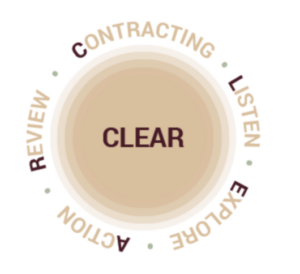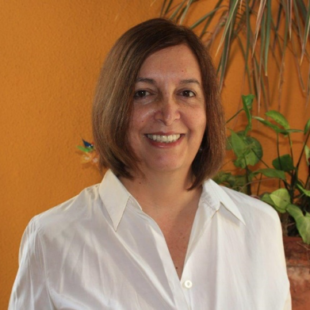CLEAR MODEL FOR STRUCTURING THE MENTORING SESSION
Accelerate your business with these expert tips "Clear Model for structuring the mentoring session" - Analyse and discover this TIP!
The CLEAR Model, a good model for structuring your mentoring session, is a good guide. Created in the 1980s by the Professor Peter Hawkins, pioneer of the supervision methodology for coaches, consultant and researcher in "Executive Coaching, Leadership and Organisational Development".
The model describes 5 phases of the session

C: "Contracting":
The mentor supports your entrepreneur to understand and focus the challenge The mentoring session will focus on what you want to address, to clarify the desired outcomes, to clarify the focus of the session, and to establish together the basis of the mentoring encounter.
- What helps you learn?
- What do you need from me today?
L: "Listen":
Through active listening (see TIP) and catalytic interventions, such as: paraphrasing, mirroring, articulating intuition, and an attitude of curiosity; accompanying the entrepreneur to increase your understanding of the situation and self-awareness.
E: "Explore":
Collect the emotional impact of the current situation in the entrepreneur and challenge him or her through effective questioning, brainstorming and (see TIP) or reflection to discover new perspectives and options.
A: "Action":
Supporting the entrepreneur in choosing the new path to follow and to define its next steps, including as a key element a "fast forward rehearsal" of the action to be taken ("Tell me how you are going to tell them..."). (Action plan).
A: "Review":
Review and consolidate the agreed action plan, and agree on follow-up mechanisms. Get feedback on the effectiveness of the session, what was useful, what was difficult and what you both want to be different in future sessions. The great contribution of this structure is that reinforces the entrepreneur's responsibility and commitment, in the relationship with the mentor, with himself/herself and with regard to the challenge he/she wants to achieve, through steps 1 and 5.
Inquire into the meaning of the initial challenge for the client, explore where the real difficulty lies, and ask the client to specify the desired outcome of the session ("If this session was really useful for you, what would we have achieved together at the end of it?) enables the mentor-entrepreneur alliance clarify the focus of the session and makes the awareness starts in the first few minutes of the meeting. Importantly, it is a co-created focus, based on the entrepreneur's concern and the mentor's enquiry and reflection.
Step 5 closes the circle by directly asking the entrepreneur to evaluate to what extent he/she feels that the initial expectation has been met in the session. This is another opportunity to reinforce the entrepreneur's sense of being in control of his or her process: measure progress, celebrate achievements, and verbalise what is not working. This is not about putting the mentor in the position of "seller" and the entrepreneur in the position of "buyer", but rather about open a constructive space to take joint responsibility for the process.
THESE TWO PHASES OF THE CLEAR MODEL ARE ALSO FULLY ALIGNED WITH ICF'S MENTORING COMPETENCIES, IN PARTICULAR WITH THE COMPETENCE:
"Establishing the coaching agreement and competition "managing progress and accountability".
I recommend it to all mentors, even if they are not preparing for certification.
The CLEAR model is a framework for guiding and structuring a mentoring session, facilitating conversation and goal achievement.
EACH LETTER REPRESENTS A PHASE OF THE MODEL:
- C - Contracting: In this phase, the contract between the mentor and mentee is established, the objective of the session and the limits of the session are defined.
- L - Listening: the mentor actively listens to the mentee, paying attention to his or her needs, concerns and problems.
- E - Exploring: the issue to be addressed is explored in depth, questions are asked to better understand the situation and different perspectives are analysed.
- A - Action planning: concrete action plans are established to achieve the objectives defined in the contract phase.
- R - Reality check: expectations are reviewed, resources needed are assessed and possible obstacles to overcome are identified.
ADVANTAGES AND BENEFITS OF APPLYING THE CLEAR MODEL IN MENTORING SESSIONS:
- It helps to structure the session and focus attention on the objectives.
- Facilitates communication between mentor and mentee, ensuring that they understand each other.
- It allows for an in-depth analysis of the situation and an identification of different perspectives and solutions.
- It facilitates the definition of concrete and realistic action plans.
- It helps to assess the resources needed and to identify possible obstacles to overcome.
- It encourages monitoring and evaluation of the mentee's progress.
In summary, the CLEAR model is a useful tool to guide and structure a mentoring session, enabling the conversation to be more effective and the defined objectives to be achieved more efficiently.
How can a mentor apply the clear model?
The CLEAR model is a very useful tool for structuring a mentoring session to ensure that all aspects necessary to achieve the desired objectives are being addressed.
THE FOLLOWING ARE THE STEPS THAT A MENTOR CAN TAKE TO APPLY THIS MODEL:
- Clarify objectives: The mentor should start the session by clarifying the objectives to be achieved. It is important that these objectives are specific, measurable, achievable, relevant and time-bound (SMART method).
- Active listening: The mentor should actively listen to the mentee, allowing the mentee to express his or her ideas and concerns. To do this, the mentor should ask open-ended questions that allow for greater depth in the conversation.
- Analyse the current situation: The mentor should analyse the mentee's current situation in relation to the goals set. This can be done by asking specific questions that help to understand the current situation and to identify the obstacles that need to be overcome.
- Explore options: Once the current situation has been analysed, the mentor should help the mentee explore different options to achieve the goals set. It is important that the mentor allows the mentee to think and propose solutions, acting as a guide and not as a problem solver.
- Resolving obstacles: The mentor should help the mentee to identify the obstacles that may be encountered along the way and propose solutions to overcome them.
- Action plan: The mentor should help the mentee to establish a concrete and realistic action plan, including deadlines and specific actions to achieve the goals set. This plan should be written and clear to both parties.
- Reflection and follow-up: At the end of the session, the mentor should help the mentee to reflect on what has been discussed and to establish a follow-up plan for the proposed actions.
In short, the CLEAR model allows the mentor to structure the mentoring session in an effective way, helping the mentee to achieve the objectives set.
TASK
NOW THAT YOU HAVE READ THIS TIP, YOU SHOULD BE ABLE TO ANSWER THESE QUESTIONS:
- What are your goals for the programme and expectations?
It is important that you think about what you want to learn before you start the acceleration programme, so that you can set goals for where to direct your time and effort.
At the end of the programme we will review what you have written about your objectives to validate (or not) the initial hypotheses and review what you have learned.
- How will you know if you have reached them?
- What tools would you use to measure your progress towards your goals?
- Visualise your 80th birthday. Imagine what you would like the end of your life to be like, how you would like to be seen, how you would like to be remembered, what work you would like to leave behind.
- Formulation of objectives:
Imagine that all your goals can be achieved. Let your imagination run wild and write down all the goals you would like to achieve in the next five years under the following headings:
- Staff: What would you like to learn, what skills would you like to master, what could you do for your physical well-being...?
- Professional: How much do you want to earn, what position do you want to achieve, what level of responsibility do you want to have, etc.?
- Affective / Family: What do you want your emotional relationships to be like, how much time do you want to spend with your loved ones?
- Contribution: How can you contribute to the well-being of others, how can you help your peers to progress, how can you improve the community environment?
Be sure to follow the MENTOR rule in the formulation.
Staff: | |
Professional: | |
Affective / Family: | |
Contribution: |
- Formulate your Action Plan to achieve your objectives in each area.
Date | Indicators | |
Staff: | ||
Professional: | ||
Affective / Family: | ||
Contribution: |
CASE STUDY OF A MENTOR APPLYING CLEAR WITH HIS OR HER ENTREPRENEUR
Clara is an entrepreneur who has just started her own event catering business. As this is her first time leading a business, she is looking for a mentor who can guide her along the path of entrepreneurship.
Clara's mentor decides to apply the CLEAR model in their next mentoring session to structure the conversation and make sure they are addressing all the necessary issues.
THE SESSION RUNS AS FOLLOWS:
C: CONTEXT
The mentor starts the session by asking Clara about the context of her business and how it has developed since they last spoke. Clara tells him that she has had some setbacks with the materials supplier and that she has had to make some adjustments to her prices in order to compete in the market.
L: LIMITATIONS
The mentor then asks Clara about the constraints she has faced in her business and how she is working to overcome them. Clara acknowledges that she is having trouble reaching her target audience and that she needs to improve her marketing strategy.
E: EXPLORATION
The mentor then explores with Clara possible solutions to her limitations and gives her some advice on how to improve her marketing and reach a wider audience. Together, they discuss different strategies and evaluate which might be the most effective for Clara's business.
A: ACTIONS
After exploring different options, the mentor and Clara decide on concrete actions Clara will take to improve her marketing and reach more customers. Clara agrees to do more research on her target audience and tailor her message to appeal to them. In addition, they agree that the mentor will review Clara's new marketing materials before she publishes them.
A: RESULTS
Finally, the mentor and Clara establish some success indicators to measure the progress of the business and ensure that they are achieving the objectives. Clara commits to tracking sales and the number of new customers that come through her new marketing strategy.
In a nutshell, Clara's mentor applied the CLEAR model in their mentoring session to structure the conversation and ensure that they were addressing all the issues important to Clara's business success. Together, they explored possible solutions to Clara's constraints, agreed on concrete actions and established success indicators to measure the progress of the business.
QUIZ
After the question and before think of yourself.
You can also consult other Related TIPs.
Learn more about mentoring by downloading this free EBOOK.
Do you want to help an entrepreneur by sharing your experience as a MENTOR? get accredited now.
Are you an entrepreneur? If you need support to boost your business, apply now for your mentor.
Rate this TIP!
Click on the stars to rate
Rating "3" - Average " - Average4.7"
No votes yet, be the first to vote!
We are sorry you did not find it useful.
Help us improve this TIP!
Leave us a comment and tell us how you would improve this TIP










